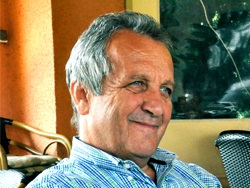Sustainable, faster and more productive aquaculture of catfish
In the face of stagnating fisheries production and health and environmental concerns raised by aquaculture, demand for sustainable aquaculture systems providing fresh, high-quality, local supply of healthy products which follow strict rules to protect the consumer, the fish and the environment has never been so high. Aranyponty Zrt., a Hungarian company producing freshwater and running a full-scale fish farm system of over 1 500 hectares at Retimajor, hopes to meet this demand with a sustainable farming technique for European catfish (Silurus glanis). Their technology is resource-efficient, eco-friendly, faster and more productive than existing alternatives, and it has received EU funding under the SME Instrument under the SILGEN (Sustainable farming of European catfish (Silurus glanis) for innovative, resource efficient and eco-friendly pond farm production) project. Ferenc Lévai, coordinator of SILGEN, details the main innovations of the project and the results of its feasibility study ahead of its end on 31 May. How does your aquaculture solution differ from existing practices? With traditional pond aquaculture, high quality (and high value) predatory fishes are cultured only in polyculture with cyprinids. The ratio is about 3-4 % of the total production. It means not more than 30-40 kg/ha, even in traditional fish farms that would qualify as ‘good’. Our target fish, the European catfish, is also a high value predatory species. Up to now this fish was mainly farmed in earthen ponds with very low density, feeding on cyprinids, or in closed systems fed by artificial pellets. Both techniques run on the borderline between loss and profit, which is why the production was so low in comparison to carp or trout cultured in Central and Eastern Europe. With our project we combine the technique of using closed systems with water recirculation and pond culture. A closed system is excellent for the production of yearlings, but table size catfish production can compete with Asian dumping of pangasius only if using pond culture. By combining yearling production in ‘Recirculating aquaculture systems’ (RAS) and table fish production in ponds we can reduce the production time to two years — instead of the three needed with the old method — and increase the yield from 30 kg/ha to 3000 kg/ha of catfish. In this case the fish is fed by pelleted feed, but can also consume a lot of natural food organisms grown in pond water. This completes the nutrients in the feed. Another difference between our new technique and the old one is that we apply pond recirculation in a special way. We use a water-saving technology where the polluted water of the intensive pond is cleaned in a low density ‘non-fed polyculture’ pond. Why did you decide to focus on European catfish? European catfish are the second largest freshwater fish (after the great sturgeon). It is a fast growing, tasty predatory species having no intermuscular bones. It tolerates low winter temperatures well (in contrary to African catfish) and can be cultured in our large carp ponds. What have you learned so far from your feasibility study under H2020 phase 1? The chance to carry out a feasibility study under SME Instrument Phase 1 has been a great opportunity to strengthen our business strategy. The good news is that our project has a seller’s market, and because it is our native species there is no danger that some individuals would escape from the culture pond into the natural rivers or lakes. We also learned that our bestselling product will be the ‘fillet fresh on ice’. It can compete well with pangasius. Freshness and short transport distances are the most important factors, and that is why using native fish will be a great advantage. What are the main guarantees you provide to consumers? The aim of the current project under SME Instrument Phase 1 is to carry out a feasibility study. However, during the Phase 2 project, we plan to carry out a widespread pilot project in our 1 500 hectares fish farm that will demonstrate the technology in a real environment and give guarantees to the customer. So you are planning to apply for phase 2 funding after the end of the project in May? What else will you try to achieve with this additional funding? Certainly we plan to apply for phase 2. The funding — hopefully awarded — will be used mainly for technological purposes and for the commercialisation of SILGEN. We plan to modify our carp ponds for catfish culture, and to carry out a selection work using ‘Marker assisted selection’ (MAS) for developing an even faster growing and resistant catfish variety. The latter work is planned with close cooperation from geneticists of the University of Pannonia in Hungary. Improving our fish processing plant will also be part of the project to aid its development. Where do you see your company in five years from now? In our own fish farm (roughly 1 500 ha) we would like to achieve circa 2 000 tons of catfish, and with other cooperating farms which account for about 5 000 ha, we would like to reach another 2-3 000 tons of catfish in five years from now. We also would like to be the main supplier of fingerlings for our partner farms. SILGEN Funded under H2020-SME-1 project page on CORDIS
Countries
Hungary



